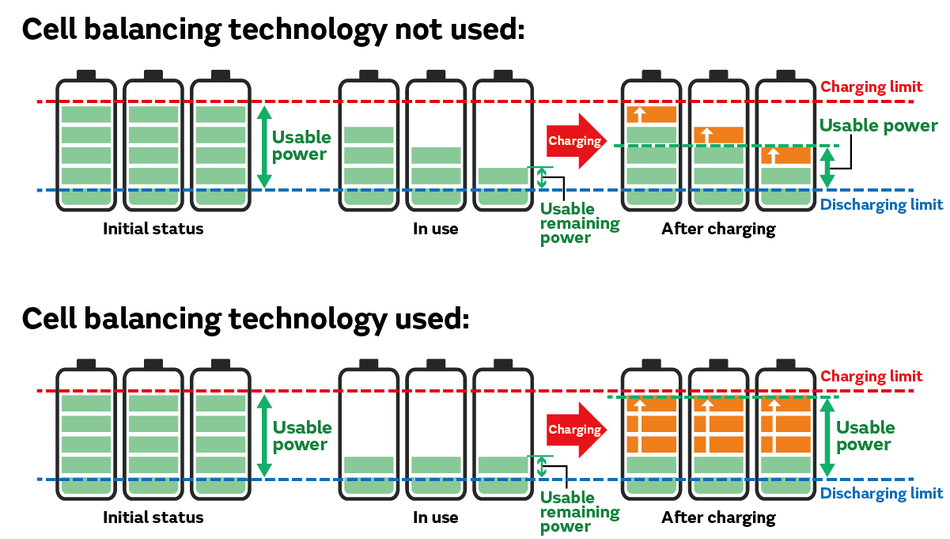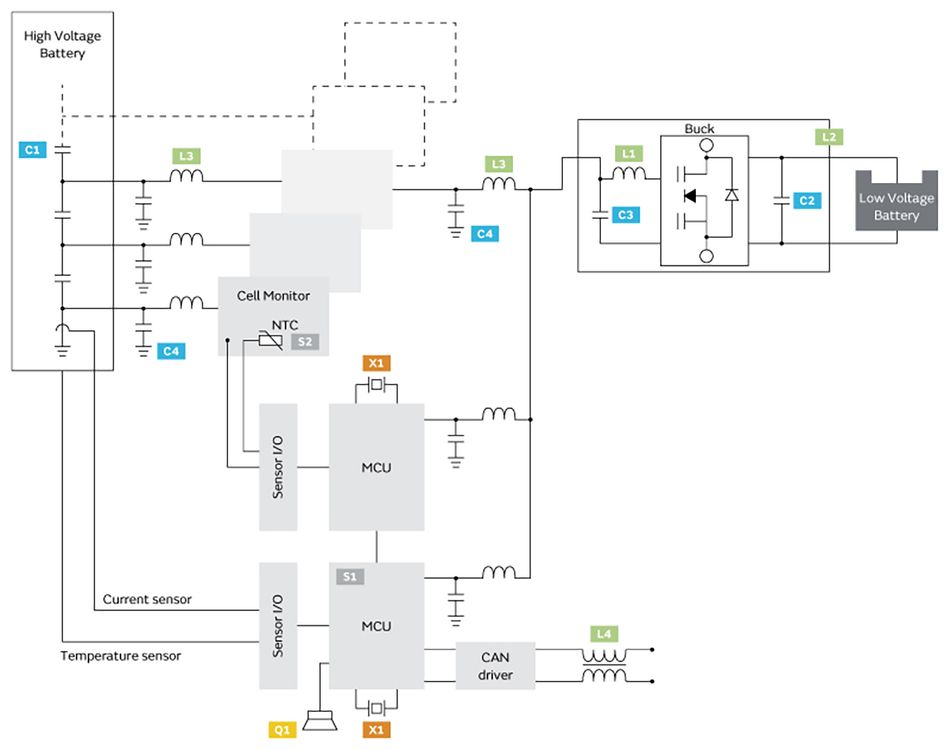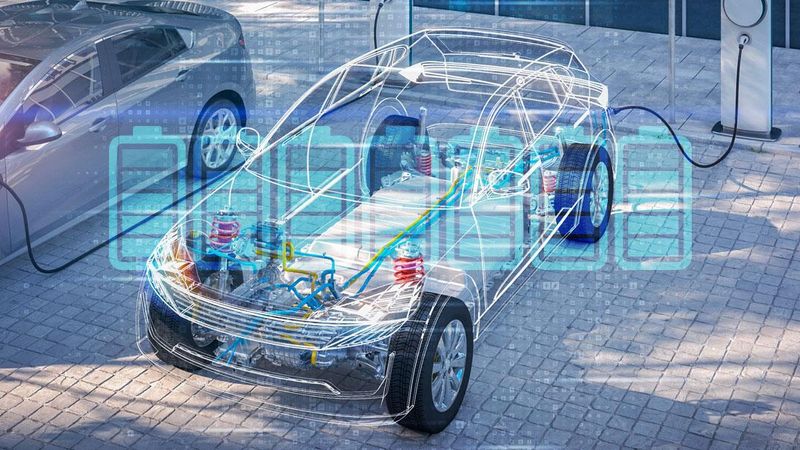Optimizing Battery Performance: Advanced Management Systems for Enhanced Safety, Efficiency, and Utilization
Several technologies have suddenly come into the spotlight in measures against global warming. Typical examples of these technologies include solar and wind power generation, electric vehicles (EVs), power semiconductors, and fuel cells.
This article was first published on
article.murata.comSeveral technologies have suddenly come into the spotlight in measures against global warming. Typical examples of these technologies include solar and wind power generation, electric vehicles (EVs), power semiconductors, and fuel cells. Among these technologies, batteries have been viewed as important and widely used for some time. However, batteries are an electrical component whose importance has risen to another level in recent years (Fig. 1).
Larger-Capacity, Higher-Voltage, and Longer-Life Batteries Are Sought for EVs and Energy Storage Systems (ESSs)
Batteries, long used in toys, flashlights and other devices, are now an indispensable source of power for notebooks, smartphones, and other mobile devices. However, devices and equipment that were previously used by burning fossil fuels are now being electrified. Moreover, the use of renewable energy is being promoted. Against this backdrop, new usage scenarios for batteries are rapidly expanding. A strong desire has now emerged for batteries with greater performance, reliability, and safety than ever before.

For example, extremely advanced batteries are sought when electrifying the means of mobility that have conventionally used powerful engines as sources of power and heat such as EVs, electric ships, and airplanes. Those batteries need to meet all advanced requirements including a larger capacity to lengthen the continuous use time, higher input/output to enable rapid charging/discharging from small to large power, a longer cycle life with no deterioration over a long time even when repeatedly charged/discharged, and improved safety to allow use even under various temperatures, vibrations, shocks, and other environmental conditions.
However, even with the batteries used in new scenarios like such EVs, the basic structure and materials used are not that different from conventional batteries used in smartphones. Lithium ion secondary batteries, the most user-friendly batteries from various perspectives including capacity, output, and life span, are being used without major improvements.
The operating voltage of each lithium ion secondary battery cell (the smallest element of a battery) is approximately 4 V when fully charged and approximately 2 V when discharged. The operating voltage is also similar in batteries for smartphones. Moreover, the capacity realized by one cell is approximately 26 Ah for those installed in the latest EVs. The capacity of batteries for smartphones is approximately 3 Ah. Certainly, that means they are a little large. Nevertheless, we can still say they are small considering that they are used to power heavy machines like EVs.
In fact, EV motors are driven at a high-voltage power of 400 V to 800 V. The capacity of the batteries that must be installed in EVs to obtain a practical traveling range is large at 50 kWh or more. Combining 1,000 or more cells and then arranging them in a series or parallel realizes the specifications of batteries for EVs. Batteries that have been given a higher voltage and larger capacity by combining a certain number of cells are called modules. Furthermore, a collection of multiple modules is referred to as a pack.
It is necessary to resolve certain issues to adopt this method of combining small cells to make large batteries.
In general, there are individual differences in the capacity, input/output, and other characteristics of each cell. Those differences arise from variations in materials and manufacturing. When cells are charged/discharged repeatedly, individual differences also arise in their strength against stress from the environment such as charging/discharging. Therefore, the individual differences of each cell tend to become larger. These individual differences have a major impact on the life span, output, and other characteristics of modules comprising many cells and the pack overall. That is because the characteristics of the module or pack will conform to the characteristics of the cell with the weakest performance and stress resistance among those used. Generally, there are fluctuations (referred to as "stress strength") in the temperature of the environment surrounding each cell and the voltage and current during charging/discharging. Therefore, the less resistant the cell, the higher the degree of deterioration. In particular, if the capacity is reduced, the power fails, or another problem arises due to over-charging (over-discharging), overheating, and internal short circuits, it may become impossible to control or drive the vehicle. That may even lead to an accident.
What Is a Battery Management System – a Key System to Effectively Use Batteries?
Against this background, it is necessary to set up an operating environment where it is possible to minimize the deterioration of each cell to maintain the performance of the modules comprising a combination of multiple cells and the packs and ensure the safe use of them over a longer period. A Battery Management System (BMS) is the control system that plays the role of closely monitoring and controlling the operation and status of each cell to achieve that purpose.
The operation and status of each cell is constantly monitored with high precision and high resolution in a BMS. Sensors that detect the voltage, current, temperature, leakage, and other factors are used to monitor the operation and status of cells. The system controls the charging/discharging to compensate for slight inconsistences and imbalances in individual cells or modules. This maintains the balance so that the characteristics are as uniform as possible. As a result, the operating life span and performance of the modules and packs are maximized while ensuring their safety (Fig. 2).

The software control in the microcomputer then checks the collected data against the usage range determined from the battery specifications and design to perform operations like the following: (1) charging/discharging control to prevent over-charging and over-discharging, which impairs safety by causing cells to deteriorate, (2) charging/discharging control to prevent dangerous over-current, (3) management of the temperature to enable safe and smooth operation, (4) calculation of the state of charge (SOC), and (5) equalization of the cell voltage to maximize the traveling range and life span (referred to as "cell balancing"). Furthermore, if over-charging, overheating, or another abnormality is detected, the BMS sends alerts to the other in-vehicle systems and informs the control circuits that have the function to disconnect the output power to prevent accidents from occurring.
There are two methods to the cell balancing function, which is an important function of a BMS. One is the passive method, in which a discharge switch is used to forcibly discharge cells with a high voltage and to convert the difference in capacity with cells with a low voltage into heat to equivalize the voltage. The other is the active method. In the active method, current is exchanged between adjacent cells with an unbalanced capacity and voltage to equalize the charging status of the cells. It is necessary to employ the active method to fully utilize the battery's potential without spare.
The performance of a BMS is determined by the diversity and precision of its embedded control functions. However, an important condition to realize this is a high level of precision in the sensors that detect the operation and status of the cells and in the many electronic components used in BMS circuits (Fig. 3). In addition, a large number of cells must be monitored. Therefore, the BMS circuit configuration itself is becoming more complex. This means smaller and lighter sensors and components are being sought.

Wireless BMSs: Installed with Many Wireless Modules
Conventional BMSs predict the operation and status of each cell by checking the data collected with the sensors against the rules and control range input in advance. Consideration is now being given to introducing technology that predicts the operation and status of each cell with even greater precision by allowing artificial intelligence (AI) to learn the trends in electrochemical phenomena in batteries. It is expected that utilization of this technology called "AI BMS" will enable the prediction of cell performance during rapid charging and the early detection of cell deterioration.
In addition, attention has been focusing in recent years on the introduction of wireless BMSs (wBMSs). This is a wireless version of the control line that connects the modules and the BMS, making it possible to reduce the number of cables between the modules. This reduces the weight and makes it easier to wire to difficult-to-access locations. It seems it is possible to reduce the length of the cables by approximately 10 m per vehicle as well as the number of connectors, transformers, and other components associated with the wire connections when this technology is applied to a BMS for EVs. Furthermore, installing cells in that empty space will also make it possible to increase the battery capacity. Nevertheless, the risk of failure increases due to instability in the signal transmission line environment compared to a wired connection.
A movement is already emerging to apply wBMSs to EVs and large energy storage systems (ESSs). It is essential to apply highly reliable and low-latency wireless technology to realize wBMSs. Semiconductor manufacturers that develop wireless ICs often propose the use of wireless technology with their own standards. Nevertheless, many of them use 2.4 GHz ISM band radio. It is likely that many small and highly reliable wireless modules will be used in EV and ESS batteries. The applications to which wBMSs can be applied will continue to expand in the future as wireless modules evolve.
If you have any questions based on this article that you would like to discuss with an expert at Murata, don't hesitate to reach out. There's an entire team ready to support you with your question.

